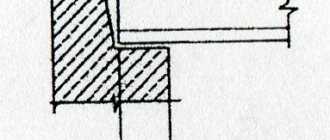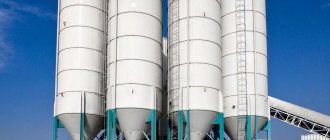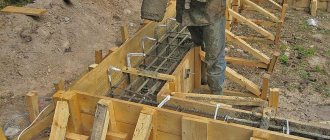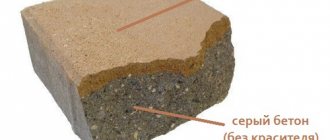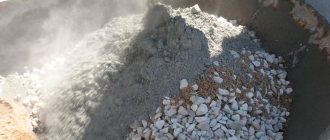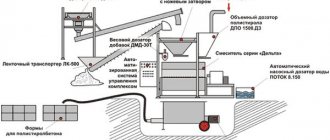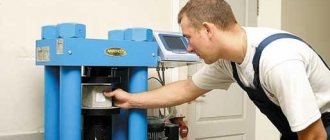A concrete mortar unit is an installation for producing concrete. If we compare with the factory, the difference will be in the configuration. However, with the help of this equipment it is possible to produce all types of concrete. At the same time, for some installations to operate, there is no need for a person to participate in the process. Some equipment options require multiple formulations.
Depending on the configuration, such devices can be mobile or stationary. The latter variety is considered classic; it is characterized by high productivity and operational efficiency. Typically, such installations are used in enterprises that engage in long-term work in one place.
Description
A mobile concrete plant allows you to produce concrete in medium quantities. Such installations are efficient and are usually used by specialists from construction and commercial organizations who work in different or remote locations. Mortar units can also be classified according to their characteristics, but their functional purpose is similar. You can verify this by reading the comparison of some models.
Different installations have their own technical features. For example, you can consider the “BRU BRUS-15G” model, which contains:
- dispenser for cement, liquid additives and water;
- concrete mixer with control panel;
- skip hoist;
- conveyor;
- dispenser;
- bunker;
- vibrating feeder;
- grab with control panel.
This installation can operate under automatic or manual mode. The operator of this type of concrete mortar unit is able to handle the installation independently or with the help of another person. The equipment can be used in regions with different climatic conditions, and the temperature can drop to -300 °C.
Technical characteristics of BSU-10/17
Among the characteristics of the described nodes, the following should be highlighted:
- performance;
- installed capacity;
- number of aggregate fractions;
- aggregate storage capacity;
- cement storage tanks;
- loading and output capacity;
- heating system at low temperatures;
- mixer type.
A concrete mortar plant can have a productivity ranging from 15 to 20 m3/h; in winter, this figure can be reduced to 10 m3/h. The storage capacity of aggregates and cement is 200 m3 and 40 tons, respectively. If we are talking about loading and output capacity, then these parameters are 750 and 500, respectively. A steam installation is used as a heating system. The power of the equipment is 40 kW, while the weight is 37,200 kg.
Characteristics of the BRU UBRS-10 installation
If you decide to choose a mobile concrete plant, then you should consider the BRU UBRS-10 model, whose productivity is 24 m3/h. This equipment uses a concrete mixer SB-146A, and the dispenser is:
- water flow sensor;
- cement dispenser with sensor and control controller;
- dispenser of inert materials with controller.
When considering a concrete-mortar unit, you should also inquire about the capacity of the open aggregate storage facility, which is 200 m3. As for the capacity of the cement warehouse, it reaches 40 m3, but the capacity of the supply tank for chemical additives is equivalent to 1.5 m3. The water supply tank can hold 3.5 m3. The dosing system in this installation is electronic-mechanical, but the ratio of mortar and concrete mixtures is as follows: 0.65/0.5.
For this equipment, the steam pressure level is 68.6 kPa; as for the working pressure of the pneumatic actuator system, it can vary from 0.39 to 0.49 MPa. Gas or diesel fuel can be used as fuel, and the consumption is 102 g/kg of steam.
Concrete mixing plant BSU is a complex of technological and auxiliary equipment that ensures the execution of operations for preparing a concrete mixture: receiving components into consumable containers, feeding them to dosing devices, dosing, feeding into a mixer, mixing and dispensing the finished mixture.
VNIIstroydormash has developed the following classification of BSU
: by the nature of the technological process - cyclical, continuous; according to the layout of technological equipment - tower, parterre-step; but the location of consumable containers - nested or linear arrangement: according to the location of relocation - stationary, inventory, inventory-mobile, mobile; according to the installation method - self-assembling, using lifting equipment; according to the method of factory readiness - multi-element, block, monoblock, according to the requirement for the supporting surface - foundation, foundationless; according to climatic design - summer, for moderately negative temperatures (up to -15 ° C), for regions of the Far North (up to -30 ° C).
Cyclic concrete mixing plants
The process of preparing a concrete mixture in these installations is a cycle of sequentially alternating operations: weighing given doses of initial components corresponding to the capacity of the concrete mixer; mixing dosed components in a mixer at a given time; unloading the finished batch.
The SB-140A mobile concrete mixing plant, with a capacity of up to 12 m3/h, with a mixer having a finished batch capacity of 250 liters, is intended for the mechanized preparation of concrete and mortar mixtures at dispersed sites.
A parterre-type installation with a rolling aggregate warehouse consists of two blocks: the first (main) block combines the main technological equipment and a sector aggregate warehouse, the second block is a cement warehouse.
The main unit has a frame (the upper part is the frame and the lower part is the support frame), on which the process equipment and control system are mounted. A concrete mixer and an operator's cabin with a control panel are installed on the frame. The concrete mixer has a separate drive for lifting the skip bucket and rotating the mixing device. Weighing dispensers for cement DC-100 and liquid DZh-YuO are installed on special stands above the mixer bowl. In the operator's cabin there is a control unit for the BAU-9D installation and a control panel, and there is an air conditioner in the cabin. A three-sector aggregate warehouse is adjacent to the vertical plane of the frame.
A DI-500 weighing filler dispenser, retractable adjustable supports, a compressor unit and transport alarm devices are installed on the support frame.
The cement warehouse is equipped with an inclined screw feeder connected to a cement dispenser.
The main block and cement warehouse are equipped with lifting devices to bring them into working or transport position.
The installation has a two-stage supply of aggregates to the mixer. At the first stage, a boom scraper device is used, at the second stage, metered aggregates are fed into the mixer by a skip hoist.
The scraper device has a boom on which a rope with a bucket is placed on blocks. The boom, rotating around a vertical axis, alternately delivers aggregates to the collapse zone. Through sector gates, the fillers alternately enter the skip ladle located on the dispenser. Upon reaching the specified mass, a command is issued to close the shutter of the dosed fraction and open the shutter in the next sector. At the end of the dosing cycle, aggregates, cement and water are fed into the mixer. The flow of the finished concrete mixture is directed by a rotary tray into the loading container.
Concrete mixing plant SB-134A
with a capacity of 20 m3/h, with two gravity concrete mixers with ready-mixed containers of 500 liters each, designed for the preparation of mobile concrete mixtures in open areas at positive ambient temperatures, at industrial, road and housing construction sites.
The installation consists of four blocks: a mixing and dosing unit, a cement warehouse, a sector aggregate warehouse, and an aggregate dispenser.
The technological diagram of the SB-134A installation is similar to the SB-140A installation diagram and differs in the mixing section. The aggregates dosed for one batch are transported by a skip hoist to the distribution funnel. At the moment of overturning the skip bucket with aggregates, the outlet valves of the cement 8 and water 6 dispensers are opened and all components of the concrete mixture are sent through the distribution funnel 7 into one of the mixers 12. After unloading the components, the skip bucket is lowered onto the aggregates dispenser for new doses.
After preparing the concrete mixture, the mixer moves away from the distribution funnel and, having reached the stop, tilts to unload the finished batch into the concrete transport vehicle. At this time, the second mixer approaches the distribution funnel and the cycle repeats.
The mixers are rolled away and tipped using a hydraulic drive consisting of a vane pump, four hydraulic cylinders and valve distribution equipment. Pressure in the hydraulic system is up to 4 MPa. The boom scraper is also rotated by a hydraulic cylinder.
The pneumatic system of the installation (pressure up to 0.6 MPa) includes a compressor, pneumatic chambers and pneumatic cylinders for water and cement dispensers.
The drive of the mixing drums, scraper winch and auger is electric.
The installation can operate in manual and automatic modes.
Concrete mixing plant SB-145-2
with a capacity of up to 40 m3/h with a forced-action rotary concrete mixer with a finished batch capacity of 1000 liters, designed for round! single preparation of mobile and rigid concrete mixtures on construction sites at ambient temperatures down to -30 ° C.
The installation is a concrete unit assembled from separate volumetric blocks of increased factory readiness, which house technological equipment for the preparation of concrete and mortar mixtures. It consists of the following elements: block 1 of aggregate bins; dosing unit for supplying aggregates; mixing block 3; 4 cement supply bins; unit of equipment for preparation, dosing and supply of chemical additives; control systems 5, as well as water supply, steam supply and pneumatic systems. The outside of the unit is covered with sandwich-type insulating panels.
The bunker block consists of four bunkers located in two sections. On top of each section there is a stand with opening lids to retain the heat of the heated material. Each of the bunkers contains tubular steam registers that provide heating and drying of inert aggregates in winter. A moisture meter is installed in the sand bunker. In the bunker space there are pipelines for supplying steam and removing condensate. The flow of steam into the registers is controlled by valves. The steam line is equipped with safety and control devices. In the under-bunker space there is a unit for dosing and supplying aggregates to an inclined conveyor for transportation to the mixing department.
The inclined belt conveyor is located in gallery 2 and is equipped with emergency stop and lighting systems, and a ladder. Pipelines run along the gallery to supply steam to the process room of the installation and return condensate.
Mixing block 3 has a welded metal frame, in which an SB-138B concrete mixer, a storage hopper with a volume of 1.5 m3, and dispensers for cement, water and chemical additives are installed. The dispensers are installed on a common frame and connected to the top cover of the mixer with elastic sleeves. The mixing block is covered from above with a volumetric structure that forms the internal space of the dosing block. The blocks are connected by bolted connections. Rubber cords are installed in the gaps between the insulating panels, which are sealed from the outside with mastic. The dosing and mixing blocks are heated by tubular steam registers connected to the centralized steam supply system.
A silo-type cement warehouse consists of two cylindrical tanks of 26 m3 each. The tanks are equipped with a loading system from cement trucks, filters for releasing dusty air, safety valves, an aeration system and screw feeders for supplying cement to the dispenser.
The block for the preparation of chemical additives is a welded volumetric structure that serves as a support for a cement warehouse. Inside the block there are TRN tanks for the preparation of three chemical additives such as START, SDB and S-3. Aqueous solutions of chemical additives prepared in tanks are fed by centrifugal pumps into the Dispenser, from which, at the command of the control system, they are sent to the concrete mixer.
The block also contains a supply tank for mixing water. Water supply is carried out by a centrifugal pump, water dosing is carried out by a DTZh-200 dispenser.
The control system provides for the installation to operate in automatic and manual modes. Depending on the weighing batchers (VDB-1500, KD-1500, KD-1500-1), modifications of installations have been developed using weighing heads, strain gauge systems that allow the preparation of at least 30 recipes for concrete mixtures, as well as microprocessor control systems based on the Computer complex SM 1810, which provide: operation of the installation in automatic and commissioning mode; automatic preparation of at least 30 concrete mixture recipes; automatic adjustment of mixing water doses depending on sand moisture content; obtaining fractional portions of the batch; adjusting the doses of components when dosing masses in order to minimize the dosing error; entry by the operator into the memory of the control system of a new recipe by erasing one of the existing ones, including during operation of the installation; issuing information about the operation and malfunctions of technological equipment and automation equipment; accounting for the availability and consumption of materials; unloading the components of the concrete mixture from batchers into the mixer in a given technological sequence; dispensing concrete mixture after a specified mixing time. An additional bank of memory and information is also possible.
The control and dosing systems for concrete mixing plants are described in detail in Chapter. 10, clause 10.5.
The entire supply system, consisting of pipelines and valves, ensures the supply of water to the mixing water supply tank and tanks for the preparation of chemical additives.
The steam supply system is designed to ensure high-quality preparation of concrete mixtures at negative ambient temperatures (up to -30 ° C), as well as to create comfortable working conditions for maintenance personnel. Steam is supplied from an external source to a distribution pipeline installed in the inert materials bin. Next, the steam enters the steam registers of the aggregate bunkers, for heating the interior, for preparing chemical additives, and for heating the mixing water.
Pneumatic equipment is designed to execute commands given by the control system when performing technological processes for dosing and preparing concrete mixtures and consists of a compressor with a capacity of up to 1 m3/min at a pressure of up to 1 MPa, control equipment, valves, pipelines, oil and water separators, executor-
them organs, air exhaust silencers. The technological sequence of actuation of the executive bodies is carried out according to commands from the control system.
Concrete mixing plant SB-167 with a capacity of up to 60 m3/h
has two forced-action concrete mixers, rotary type, with a finished batch capacity of 1000 liters each.
In terms of purpose, composition and technological scheme, the SB-167 installation is similar to the SB-145-2 installation and its modifications. A distinctive feature is the use of two concrete mixers to ensure a productivity of 60 m3/'h, due to which the specific indicators change.
The installation consists of separate blocks of increased factory readiness to ensure installation within 10 work shifts, subject to advance preparation of foundations, thermal, water and electrical communications.
Cyclic tower-type concrete mixing plants
are better suited for insulation, allowing to reduce the time of intermediate transport operations during the passage of mixture components through the technological cycle.
The concrete mixing plant SB-6B-P (6.9) with a capacity of 16 m®/h has two gravity mixers with a finished batch capacity of 500 liters each and a single-stage supply scheme for the initial components of the mixture. The tower-type installation with a metal frame and an adjacent inclined gallery for a belt conveyor consists of four sections: distribution (upper), supply bins and dosing compartment, mixing compartment and bins for dispensing the finished mixture.
Fillers of four fractions are fed into the upper section, where, using a rotary funnel 2, they are directed to the corresponding compartments of the hoppers 7 and 8.
The cement is supplied by a horizontal screw conveyor 3 and by an elevator 4 along distribution chutes it is sent to one of the two compartments of a cement silo of the corresponding brand. The presence of material in the bin compartments is controlled by level indicators.
The dosing department has two aggregate dispensers, one cement dispenser and water and chemical additive dispensers.
The dosed materials fall into the 9 n receiving funnel and then into the concrete mixers 10 located in the mixing section. The control of the dispensers and concrete mixer is located in the corresponding sections. The finished concrete mixture is unloaded into distribution bins I.
Continuous concrete mixing plants
With the cyclic method of preparing a concrete mixture, approximately 1/3 of the cycle time is spent on auxiliary operations: cutoffs during dosing, loading components into the concrete mixer and unloading the finished mixture. In continuous installations, all these processes are combined, thereby increasing productivity, reliability, and improving specific indicators. In a continuous process, the components of the mixture enter the continuous concrete mixer in a thin layer and they need to be mixed with each other only in the transverse direction, so the energy and time required to obtain a homogeneous mixture is approximately half as much as in cyclic concrete mixers, where it is necessary to evenly mix the entire mass loaded into concrete mixer in separate doses.
The disadvantages include the labor intensity in switching from one brand of concrete to another, the resulting losses, which lead to increased cement consumption.
Continuous installations are most effective at road airfield, hydraulic engineering, reclamation and other types of construction sites where frequent changes in the composition of concrete mixtures are not required.
Concrete mixing plant. SB-109B (6 10) with a productivity of 135 m8/h is designed to provide concrete mixture for high-speed road construction. The installation is block-based, mobile, and consists of trucks, the frames of which are made in the form of semi-trailers of the fifth wheel type. The technological equipment is arranged in a parterre layout in an open area and is used at positive ambient temperatures.
The installation consists of a mixing unit 5, an inclined conveyor 4, cement dosing units 3 and aggregates 2, loading conveyors 1 (three units), a control unit 6, a unit of chemical additives and water.
The mixing block is a spatial welded structure, on the basis of which a concrete mixer and equipment for loading concrete trucks with ready-mixed concrete are mounted
The dosing unit consists of three supply bins 2 aggregates and a warehouse 3 cement. Under the aggregate bunkers there are continuous batchers with an adjustable capacity of 20...100 t/h, under the cement warehouse there is a cement batcher with a double-drum feeder and an adjustable capacity of 15...50 t/h. To configure the dispensers, a calibration dispenser AVDI-2400 M is provided.
During transportation, the dosing unit is divided into two. The upper block includes filler hoppers with dispensers. In the working position, the frame of this block rests on the racks of the lower block. A collection conveyor and a cement warehouse are installed in the lower block. In working position, the cement warehouse is installed vertically.
When moving to the transport position, the cement warehouse is rotated using a crane to a horizontal position and placed on an upper block, which is removed by a crane and installed on a tractor-trailer and a dolly. The cement dispenser is disconnected and, together with the funnel, secured to the frame with hinged bolts. During transportation, all dispensers are locked.
The aggregates are fed into the supply bins by three inclined belt conveyors with receiving funnels. The supply bins are equipped with lower and upper level indicators, which include and. turn off the conveyor belts.
The cement warehouse is loaded by cement trucks or from a centralized cement warehouse. The warehouse is equipped with level indicators to automate the loading process. The sampled components of the mixture enter an inclined conveyor and are sent to the mixer.
Water, mixed in specified proportions with chemical additives, is sent by a centrifugal pump to a supply tank with a constant level maintained by freely draining excess solution back into the container of the liquid additives block. From the supply tank, water with dissolved additives is fed through a calibrated hole into the mixer. The water supply is regulated *by a dosing pump.
In the mixer, the components of the concrete mixture are mixed and simultaneously moved to the discharge neck and onto the dispensing conveyor.
The installation control scheme provides for an automatic operating mode, remote control of all mechanisms from the main console and control of all mechanisms from local consoles during commissioning work. The main control panel, automation and power equipment cabinets are located in a mobile trailer.
Development trends of concrete mixing equipment
Further improvement of concrete mixing equipment will be developed taking into account year-round operation (up to -40 ° C) in connection with the expansion of construction in the regions of Siberia and the Far East; use of the block principle of design of increased factory readiness; widespread implementation in high-performance microcomputer installations; application of control over heating of aggregates and delivery of concrete mixture at a given temperature; the use of continuous and cyclic-continuous concrete mixing plants; the use of mechanized mixers at sites with low consumption of concrete mixture, equipped with a manual scraper with a small sector storage of aggregates and cement dispensers.
Characteristics of FIBO INTERCON M2200 concrete unit mortar
If you decide to purchase the equipment described in this article, then you should consider a concrete-mortar unit from a foreign manufacturer. The model was mentioned above. It is based on a three-axle trailer with a front axle and sectional aggregate bins. The latter can be crushed stone or sand.
For its power class, this equipment is the most compact installation in the world. Equipment requires:
- water tank mixer;
- pump conveyor for supplying chemical additives;
- automatic high pressure cleaner.
The volume of the mixer can vary from 1500 to 2200 liters, while the water tank can accommodate 500 liters. Its additional functions are a heating option and a dosage system.
The pump has volumetric dosing, the purifier operates at a pressure of 160 kW. Operating this concrete-mortar unit will be quite simple, because it has automatic control for 25 recipes with calculation of loads, time tolerance and dosing control. The solution can be adjusted manually based on the moisture content of the sand. The loading protocol is displayed in the production diary; if necessary, protocols and invoices are printed. The unloading height is 1120 mm.
What is a concrete mortar unit?
Concrete plants regularly supply their products to various facilities. But what should a customer do if he needs large volumes, but the manufacturer has many other orders? Or the prompt arrival of road carriers is impossible due to reasons such as remoteness and road conditions. In these cases, construction organizations prefer to use special equipment known as a concrete mortar unit (BRU).
Characteristics and types
A concrete unit is an installation designed for the production of almost all types of concrete. Externally it looks like a tower and consists of the following elements:
- Capacity for pumping and storing Portland cement.
- Screw dispenser for feeding binder into the mixer.
- Mixing hopper.
- Dosing units for storing and supplying fillers.
- Container for water.
- Reservoir for chemical additives.
- Control block.
A concrete mixing unit makes it possible to organize the preparation of mortar in industrial quantities in a small area. It is used when working with objects remote from highways and large production centers, during the construction of bridges, monolithic buildings, during the construction of roads and the like.
There are 2 types of nodes:
1. Stationary, otherwise called a mini-factory. Installed directly on the premises of large mixture manufacturers for the production of individual types or grades of concrete.
2. A mobile concrete unit is a mobile unit on wheels, convenient in that the preparation of the solution can be organized directly on site. The cost of the finished product is almost identical to the price of mixtures from large factories.
Depending on the characteristics of the technological process, the units are divided into:
- Cyclic, that is, concrete is dispensed in portions. Until one cycle ends, a new one will not begin. The mixture is of high quality, with precisely dosed components.
- Continuous action. The processes of mixing and dispensing products occur simultaneously and continuously.
Selection of BRU
A concrete unit is a specific product, so the choice is primarily made according to the following parameters:
1. Equipment (volume of containers for raw materials, type of mixer, chemical additive dispensers, heating system for operation in winter and other elements).
2. Power, kW.
3. Number of filler fractions.
4. Operating modes (automatic, manual).
5. Productivity (from 10 m3/hour and above).
Another important aspect is the quality of components and assembly. Most manufacturers of industrial equipment have launched the production of BRUs from domestic and imported parts, which has a positive effect on the operational characteristics of the units and, of course, on the quality of the produced concrete mixtures.
So, if screw dispensers cannot ensure timely sifting of the cement binder and separate fine suspension from lumps, then this negatively affects the finished concrete. According to experts, Italian components (containers, gearboxes, motors, pneumatic valves, etc.) are better designed than Turkish or Chinese ones.
Attention should also be paid to the most expensive element of the BRU - the concrete mixer. Performance and energy consumption depend on its functionality. They produce 2 varieties:
- The gravity module consists of a rotating drum, along the inner arch of which blades are reinforced. The design is simple, the electricity costs are small, the fractions are any. However, it is very difficult to achieve homogeneity of the mass in this mixer, so they are used only for plastic solutions.
- With forced mixing. They are a fixed hopper in which rotating blades mix the raw materials. In such a plant it is possible to produce rigid, cast or plastic concrete of any grade.
When choosing, warranty plays an important role. If the factory specifies a warranty period for moving parts of less than 1 year, then you should look for another supplier.
Quite good components are supplied by Russian ones. All devices are equipped with German, Japanese and Italian equipment. Thus, the “Brig” series of stationary control units offers a fairly simple design, but reliable installation for all-season use with a capacity of up to 25 m3/hour. The mobile set “Topol 45” on wheels and pneumatic supports produces up to 45 m3/hour, and installation will take no more than 3 hours. Cost – from 600,000 rubles.
Turetskaya supplies the Russian market with not too expensive, but high-quality concrete all-season and summer units. Productivity is from 10 to 240 m3/hour, the price of installations starts from 800,000 rubles.
hardstones.com
